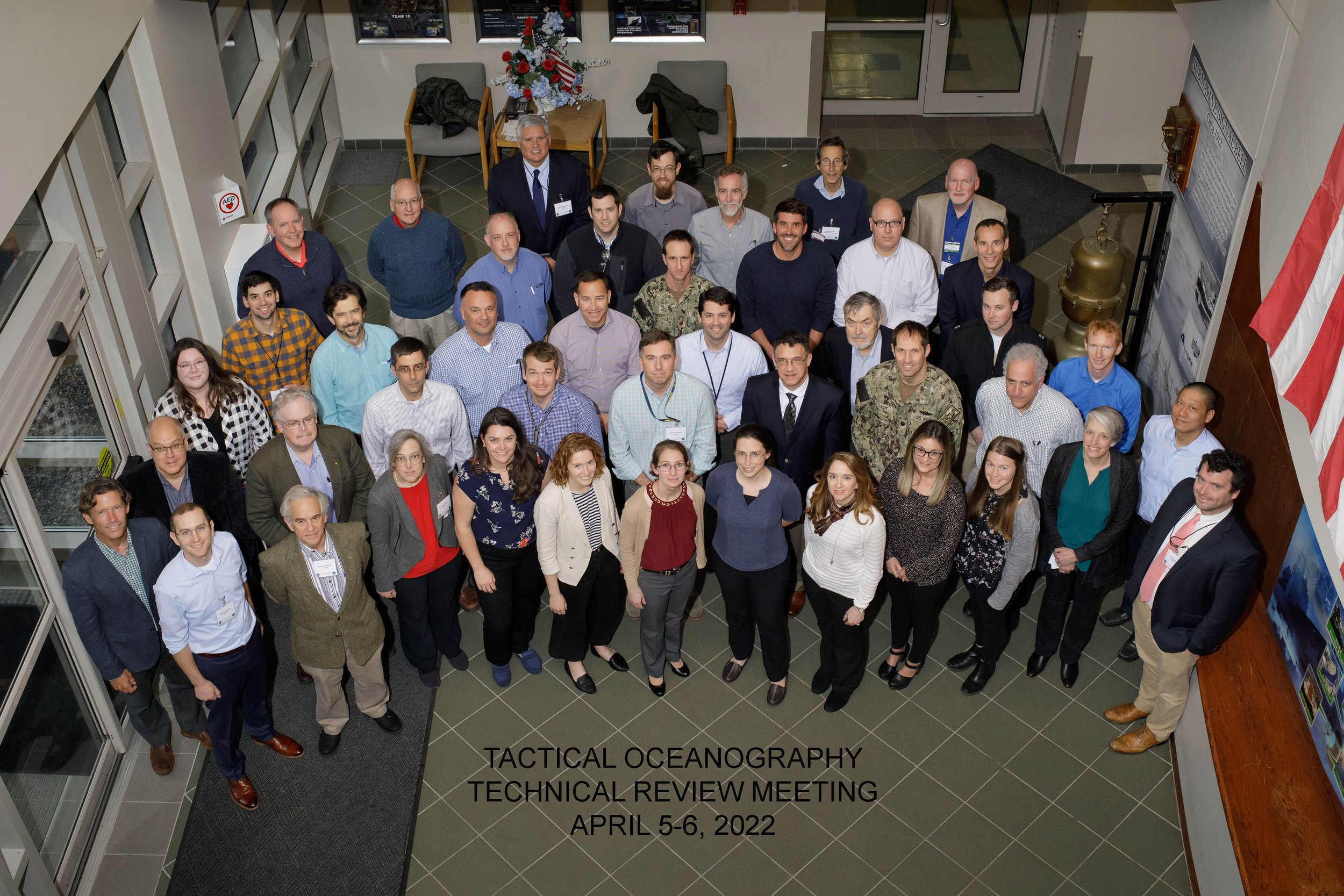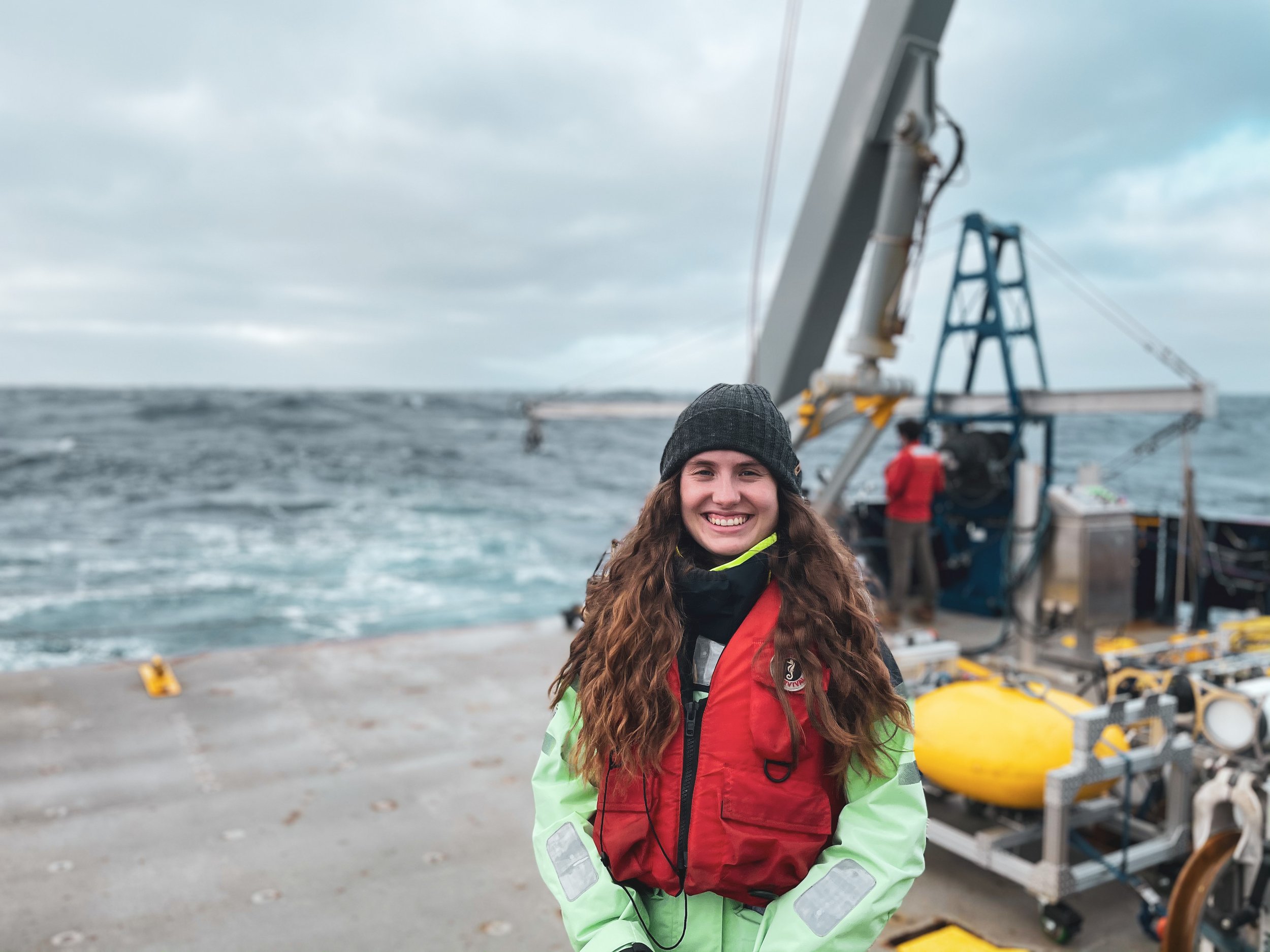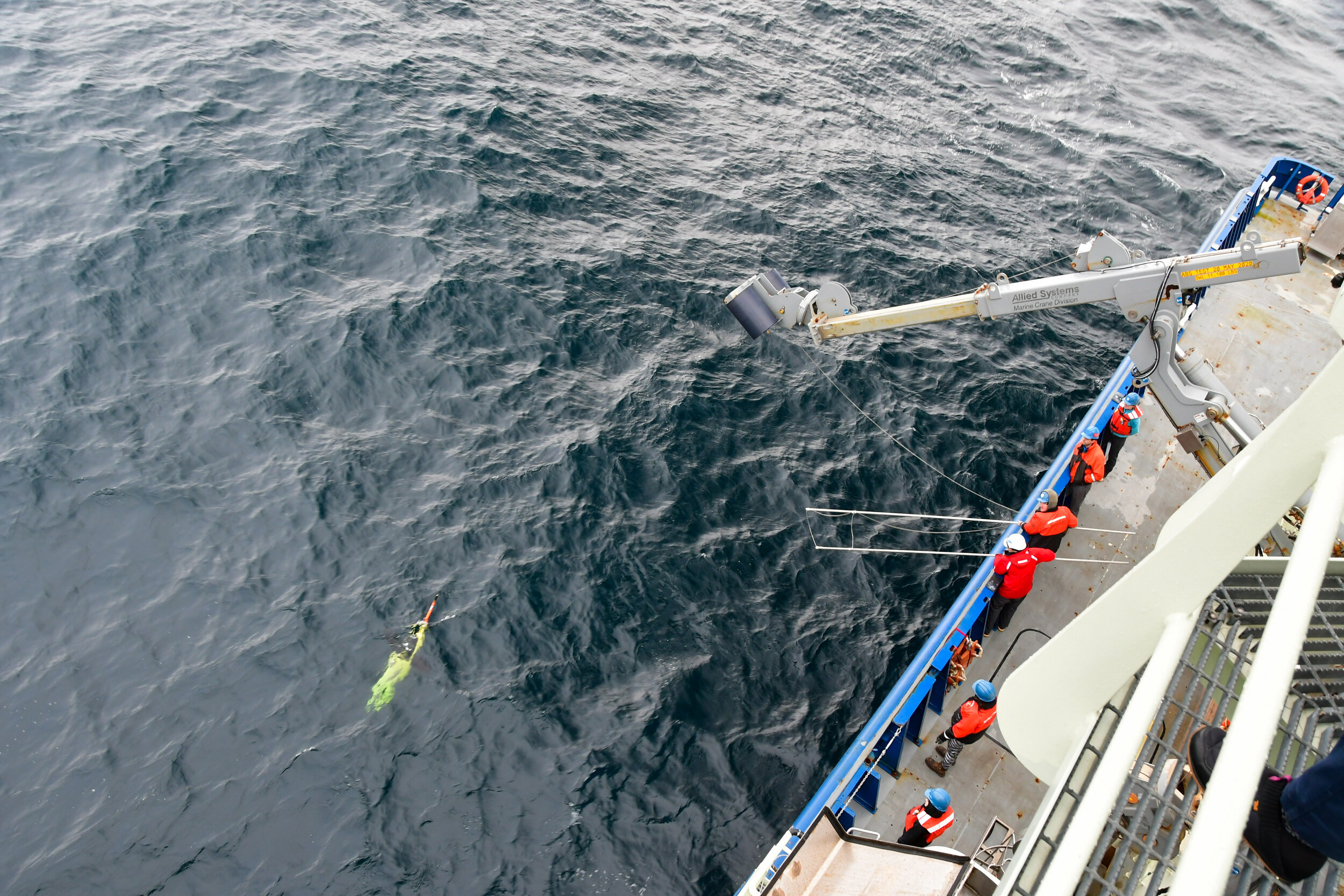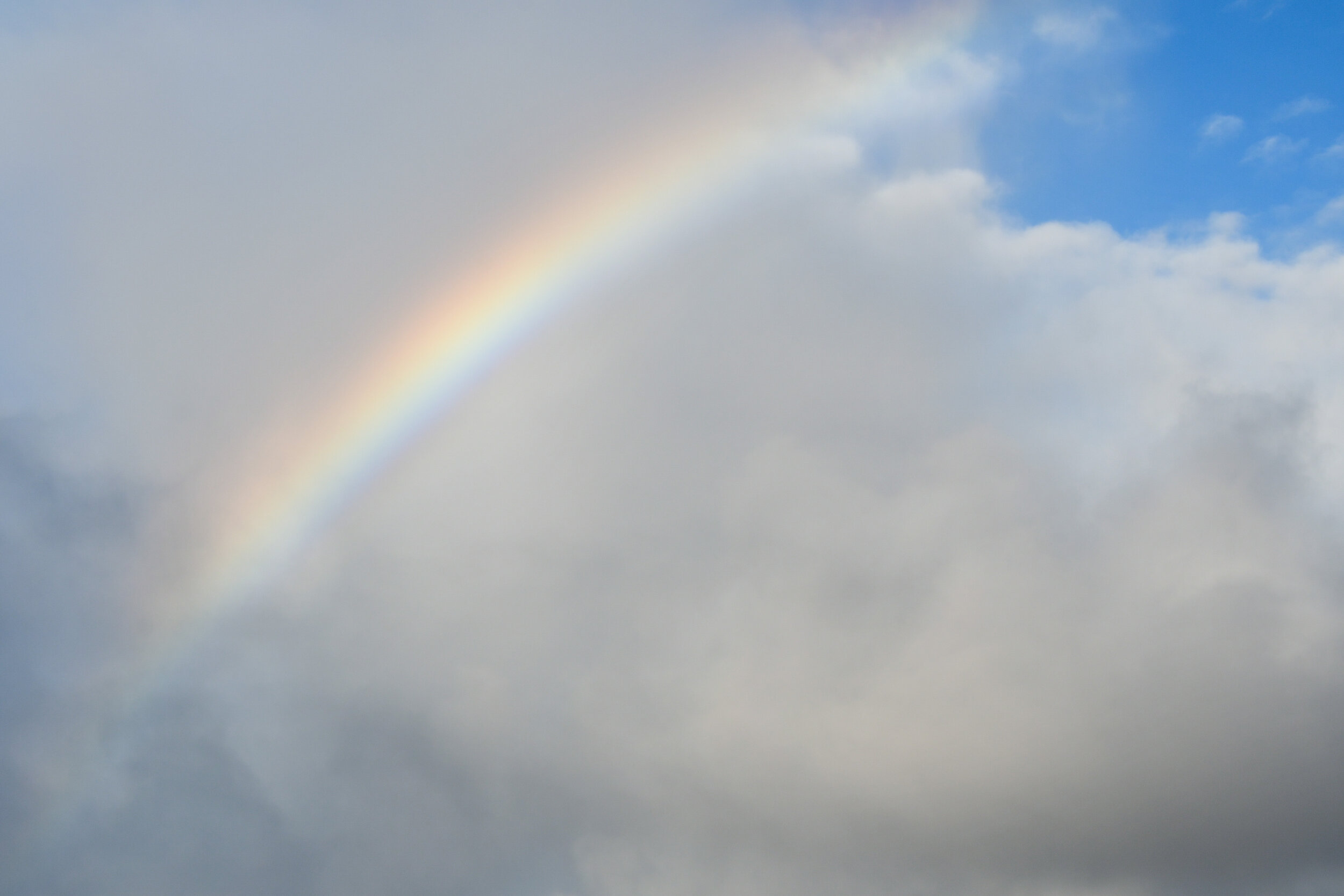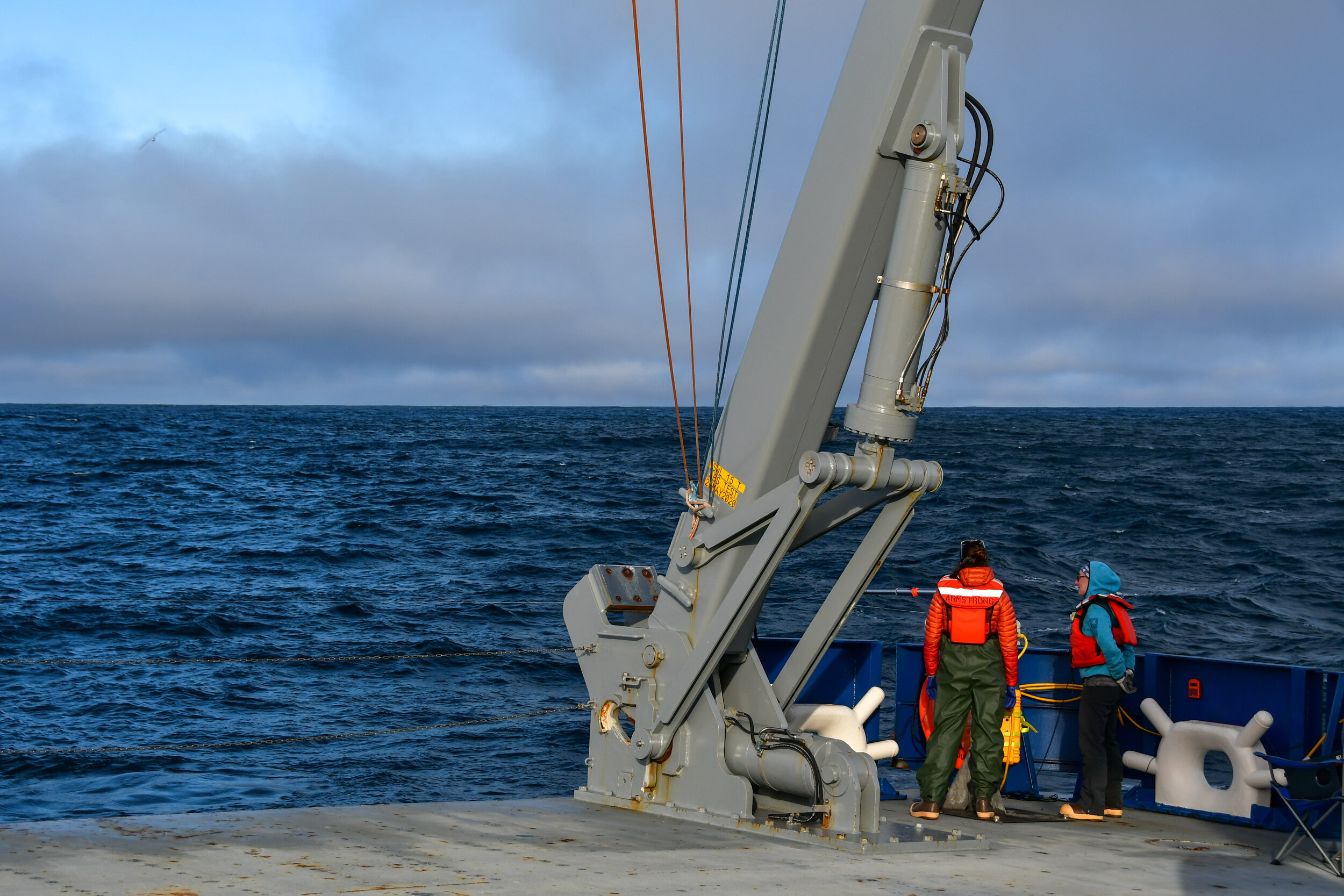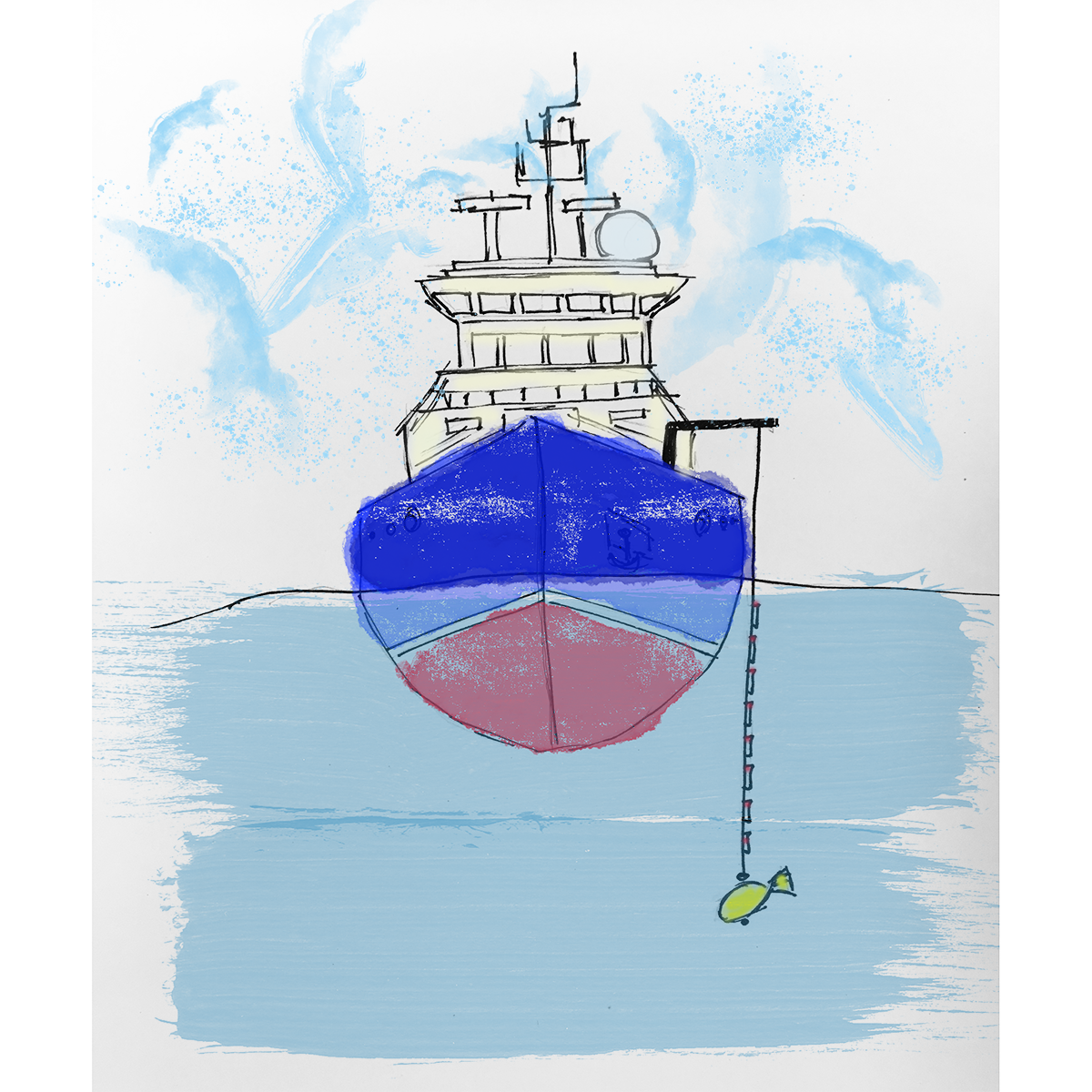122 years ago today, the US commissioned its first submarine. Today, submarines are a key aspect of national security and nuclear deterrence. The Navy funds a good part of MOD’s work, in part because our ocean understanding and measurement techniques help submarines operate more safely and effectively. As an example, MOD scientists Matthew Alford and Drew Lucas, together with a number of former Scripps students including Oliver Sun, Maddie Harvey and Adrian Doran, participated last week in a colloquium of submarine operators, acousticians and oceanographers from academia and the Navy. These collaborations are strengthening the connections between academia and the many submariners who bravely work beneath the sea surface, for whose service we are grateful.
Engineering Advances: APEX-epsi
MOD is always working on new instruments to measure the ocean in novel ways. Recent advancements in integrated circuit technology (despite the global supply chain woes) have stoked increased interest, both within MOD and the oceanographic community at large, in taking complex measurements from autonomous vehicles. Although MOD is one of the world leaders in ocean mixing and turbulence measurements, in part because of our epsilometer technology, we have been limited to taking these measurements from research vessels. That all changed this February when MOD deployed the epsilometer on an autonomous platform for the first time. We collected 3 days of microstructure data (10 profiles over 700 vertical meters) off the coast of San Diego from an APEX Argo float.
A quick aside: the Argo program is one of the greatest collaborative efforts of global oceanography in human history. Member countries as diverse as South Africa, the US, Japan, and many more deploy autonomous floats of several varieties which measure a number of essential ocean variables across the top 2000 meters of the ocean. These floats last for many years and telemeter data over the Iridium satellite network, thus removing humans and expensive research cruises from the data collection process. All of this data is then made publicly available for ocean science and beyond.
Because they have extremely low-power and low-bandwidth requirements, APEX floats are heavily constrained on the instrumentation they can carry;. Until now, turbulence measurements have been too power- and bandwidth-hungry to collect from floats. MOD, through significant engineering effort and in collaboration with the float group at the University of Washington, has integrated an epsi sensor for turbulence measurements onto an APEX float. We deployed the first prototype from the R/V Bob and Betty Beyster on February 14th, 2022, recovered the float later that week, and are currently in the process of validating the data. This first test will inform the incoming on-board processing necessary for our sensor to become an off-the-shelf option for the Argo fleet. We plan to deploy more APEX-epsi floats later this year and are incredibly excited about enabling new frontiers in ocean science!
MOD Student Spotlight: Bethan Wynne-Cattanach
Bethan Wynne-Cattanach on deck with the FastCTD in the background.
Tell us a bit about yourself and what you are studying now —
I am a fourth-year PhD student in the Physical Oceanography (PO) program at Scripps. I completed my undergraduate degree in mathematics at Trinity College, Dublin before doing a year-long Masters in PO at Bangor University in the UK.
Broadly, I study turbulent processes near topographic features. My current focus is the Boundary Layer Turbulence experiment that began in the summer of 2021. The aim of the project is to understand how processes close to steep topography, particularly along continental slopes, lead to upwelling. This is an important question related to our understanding of the global overturning circulation. My contribution is primarily looking at data collected using MOD’s FastCTD during a dye release we did as part of the experiment.
What keeps you excited and interested in working in the field of oceanography?
Going to sea has probably been the most exciting part of working in the field of oceanography. Although my work has focused on processes in the deep ocean, being out on the water, witnessing the varying conditions and observing features like fronts, slicks and big waves in person has made the problems I’m studying feel much more tangible. Having that connection to the data has been very inspiring. It is also a reminder of the vastness of the ocean and how little we really understand about how it all works. Which, although daunting, motivates me to try and fill in a little bit more of the puzzle.
When you were a kid, did you expect to be a scientist or engineer?
I was always curious about science as a child, but I didn’t realise that I could be a scientist when I grew up. Despite not having a clear path in mind, I knew that I had to follow my passion for mathematics when I went to university. I was lucky enough to have the opportunity to just do what I loved and figure out how I was going to make it my job later. My experience has made me realise how important it is to show children that there is a wide range of exciting career options in science.
What skills or abilities do you think are useful when applying to graduate school in oceanography?
I think one of the great things about oceanography is that you can come in from so many different backgrounds. This could be previous experience in the earth sciences, physics, maths, engineering or countless other fields. For physical oceanography, having some previous experience with maths or physics is useful but the key is to be curious and to have a desire to apply the analytical skills developed during an undergraduate degree to problems related to the ocean.
What drew you to study at Scripps?
As someone who was applying to graduate school with very little background in oceanography, Scripps seemed like the best choice – the PO program has a full year of classes before beginning research allowing exploration of the field before choosing a thesis topic and we also have the chance to meet with professors and researchers during the first year before deciding who we’d like to work with. My experience at Open House showed me that there were plenty of incredible people to work with and the atmosphere and location of Scripps really couldn’t be beaten!
MOD student spotlight: Bofu Zheng
Bofu Zheng, PhD Candidate, doing field work as part of the NSF-funded SUNRISE cruise in the Gulf of Mexico in 2021 (Photo by Jen MacKinnon).
Tell us a bit about yourself and what you are studying now —
I did my undergraduate in Zhejiang University, China, with a major in mechatronics engineering. After graduating in 2017, I came to Scripps for my graduate school adventure. Currently, I am a fifth-year PhD candidate, trying to understand some coastal bio-physical interaction problems with the help of high-resolution observational data collected from novel sensors and platforms.
What keeps you excited and interested in working in the field of oceanography?
Many reasons actually. I really love the ocean because it gives me the feeling of freedom and reminds me how tiny human beings are compared to mother nature. Working in this field, especially on a research ship, provides me a unique opportunity to combine my interest with my job, which I appreciate very much. Also, the more I learn about the ocean, the more I feel that there are so many things that remain to be discovered. She is so beautifully organized and mysteriously interesting, which always triggers me into deeper thoughts.
When you were a kid, did you expect to be a scientist or engineer?
Honestly, I did expect myself to be a scientist when I was a child, without any understanding of how hard it might be. When I look back, I feel very fortunate that I am now at a place very close to this childhood dream, with gratitude to lots of people’s help.
What skills or abilities do you think are useful when applying to graduate school in oceanography?
I think the top thing on my list is that you need to have an intense interest in what you are applying for. A PhD is a relatively long journey and sometimes you may be in a difficult situation with limited help, such as getting stuck with in an academic problem or stress from work. At these times, a strong interest in your work will be one of the key forces carrying you through. I always believe interest drives primary productivity. So, listen to the voice from the inner part of your heart before application. Moreover, if possible, I think it will be very useful to reach out to the professor you are interested in. This is not only for the professor to know you, but also, more importantly, for you to learn about the professor’s lab, potential projects, and personality.
What drew you to study at Scripps?
Scripps is definitely one of the top oceanographic institutions in the world, so it has always been my dream to come to Scripps to study. When I prepared my application for graduate schools, I was planning to do something related to ocean instrumentation as an extension of what I learned during my undergraduate. Unlike oceanography programs in many other universities, I feel lucky that Scripps offers a program with focuses on the engineering side of marine science, which is what I ended up in - the applied ocean science curriculum group. It is a good match for students who are interested in learning science with some engineering backgrounds. Furthermore, during my application process, I learned about the amazing science and engineering projects that Rob, Matthew, and Drew were doing, which made me want to come to Scripps more!
NORSE pilot signing off
Hello there,
Greetings from the party aboard the Armstrong. The NORSE pilot has entered its last week and we’ve wrapped up the last few deep CTD casts, deployed some more surface drifters, recovered the SWIFTs and are in the process of picking up all the different gliders we deployed earlier.
Recovering a sea glider.
Last week a bit of nasty weather (30ft waves and 50 knot winds…) had us holed up behind Jan Mayen for a few days. But the spirits remained high onboard. We caught up on sleep, watched some movies and had a few dance sessions in the lab. We also celebrated two birthdays (MOD’s own Ale among them) with plenty of delicious cake, colorful balloons and origami dinosaurs, because that’s the proper way to do it on a ship. When things cleared up we were greeted by both sunrises and rainbows.
This week involved more uCTD-ing and bow-chaining, more than one big wave that made the ship roll enough to have things flying around the lab, and a few slightly panicky moments for some of us as the internet access went down just when we tried to submit abstracts to Ocean Sciences (thankfully the satellites decided to come back in time). More than one instrument has also started acting up a little after almost five weeks at sea, but thanks to a wonderful, resourceful and talented science party and Armstrong crew things have been surprisingly smooth (everything but the waves that is) and full of laughter, and we will be coming home with some really cool data. It will be put to good use in shaping the NORSE project's next few steps and to develop the sampling plan for next year’s cruise that is scheduled to take place in the same region in the fall of 2022.
uCTDing in nice weather is not too bad… (Don’t worry, we’ve done plenty of sessions in the dark with cold rain and big waves washing over the back deck too.)
A massive thank you goes out to the fenomenal crew aboard the Armstrong who’s skill and good humor in putting up with our ever changing plans and ideas (like going back up and down the same 6nm transect at 2 knots three times in a row while uCTDing to investigate a peculiar wiggle we spotted at the base of the mixed layer) has been crucial to the success of this cruise. Another massive thank you to all the collaborators and colleagues back on land supporting us with everything from packing and loading, setting up and trouble shooting instruments, context data and moral support.
We have another day or so of work out here and then it’s a-boat time to head back to Reykjavik and sail-abrate a successful five weeks at sea. We’ve done a lot of great science, seas-ed many a day, and have many a good story to tell (fear not, they all have ferry-tail endings).
The NORSE pilot science crew in front of Jan Mayen, left to right: Dave Morton, Kerstin Bergentz, Allison Ho, Alejandra Sanchez-Rios, Laura Crews, Justin Burnett, Luc Rainville, Laur Ferris, Anna Savage, Raymond Young, Sam Brenner, Angel Ruiz-Angulo - a true dream team!
Signing off for this time with a final picture of the science party of the NORSE pilot 2021.
Over and out!
Text and photos by Kerstin Bergentz
Glider galore and glaciers - NORSE
Ahoy, ahoy, greetings from the Armstrong!
We’re having a knot too shabby of a time up here in the sea-nic north.
(“You’ve yacht to be kidding, you’re anchor-rigible. These terrible puns are keeling me…”)
Last week was an exciting one. We’ve been going back and forth around and across the Atlantic Front Current doing repeat sections with the bow chain and underway CTD, as well as plenty of deep CTD casts. The cruise track so far can be found here (don’t worry, there is a method to the madness of our seemingly random crisscrossing).
Credit: Luc Rainville, APL
In particular we deployed a bunch of different types of gliders that have been collecting data on temperature and salinity as well as the microstructure and acoustical properties of the water. The majority of the gliders are subsurface, but we also have one Wave Glider that travels on the surface and can measure atmospheric and surface wave parameters too. However, they all require some form of piloting. Basically, we have to tell the glider where we want it to go but at the same time be careful so as not to exhaust the limited power and memory. Some of the piloting is done by the scientists onboard the Armstrong and some by other colleagues and collaborators across North America and Europe.
Sea Glider deployment.
Besides very serious science we did some other fun stuff last week.
First there was a quite realistic fire drill involving a smoke machine on full power and a ‘missing’ member of the science party, and then we got to try on the suits (boots, pants, jacket, gloves, face mask and air tank) used in case there is a fire onboard that needs to be put out. Definitely harder and heavier than you’d think!
Dr. Savage donning a fire suit.
Soon-to-be Dr. Ferris in a fire suit.
Then there was an emergency recovery mission. One of the SWIFT drifters we deployed earlier ended up getting a little bit too close to Jan Mayen for us to be able to recover it from the ship. Hence we launched the small boat and sent three people in red suits (Anna had to quickly change out of the fire proof one) to go pick it up from where it was hanging out near one of Jan Mayen’s glaciers.
The rescue team.
Small boat, big glacier.
R/V Neil Armstrong as seen from the water.
A SWIFT in front of Jan Mayen.
We’re happy to report that everybody survived the fake fire and that everyone made it back onboard the Armstrong safely, including the runaway drifter.
We’re keeping a close eye on the forecasts (obsessively updating windy.com, anyone?) and it seems like there is some more rough weather coming for us, this is the North Atlantic in September after all, thus there will be some more hiding behind Jan Mayen in the upcoming days. In addition to that, we also have not one, but two(!) birthdays in the science party to celebrate this week. Exciting times ahead!
Signing off with a picture of the clouds enveloping a snow-covered Mt Beerenberg on Jan Mayen and a final bad pun, promise (for today at least):
Q: What is a sailor’s favorite breakfast?
A: Boatmeal!
Text and photos by Kerstin Bergentz
NORSE party dancing and Jan Mayen
Hello there, nice to sea you!
(Apologies in advance for all the terrible puns that will be coming your way, this is what happens when you’re out at sea for too long…)
All is well aboard the Armstrong. Last week we watched a bunch of sunrises, successfully deployed a bunch of drifters, a float and some gliders. Everything went smoothly and we’re seeing some interesting data coming back. We’ll let some of the instruments go off and do their thing and then pick them back out of the water a little later in the cruise.
Glider deployment
Drifter deployment
Right before the weekend we also did some more bow chain and underway CTD sampling on the edge of the Lofoten Basin. The sun was shining and we brought out the speaker, because, let’s be fair, the only way to get through 10h of continuous CTD-ing and manning the winch is with some good, dance friendly tunes. Our funky moves were also captured on the R/V Neil Armstrong twitter feed (check it out here ). We even saw whales and we all agreed it was a pretty good day for doing science.
It’s a deck dance party!
But as soon as the instruments were out of the water we set the course northwest, full speed ahead, to try and get out of the way of some nasty weather. We've spent the weekend hiding behind the island of Jan Mayen who graciously shaded us from the worst of the wind and waves.
Jan Mayen is a small Norwegian volcanic island that hosts a research station, a few glaciers and reportedly pretty good hiking trails. The last time Beerenberg (the world’s northernmost volcano above sea level) erupted was in 1985, but yes, the irony of trying to avoid a bad storm by cozying up next to an active volcano was not lost on us.
It’s still been windy here though, 30+ knots (the bridge reported it was upwards of 50 knots at times) and the SWIFT drifters we deployed as we raced here Saturday later recorded wave heights of around 5 meters, but we got only about half of that.
We woke up yesterday morning to see Jan Mayen covered in snow and the sun shining. The wind and waves still being strong we stayed put for most of the day, admiring the views and getting caught up on emails, exercise, laundry and the like.
The island of Jan Mayen. Mt Beerenberg at 2277m gave us good shelter.
We’ll hang around in this region for a bit, sampling the Atlantic Front Current as it flows along Mohn’s Ridge on its way up toward Svalbard. In this region the Atlantic Water it carries gets modified by waters from the Icelandic Basin and Greenland Sea with lots of interesting large contrasts in surface properties as a result. We’ll also do plenty of deep CTD casts and repeated upper ocean sections to better understand the waters here around Jan Mayen, which is a possible future location for a moored acoustic array that would be part of NORSE. Science!
We’ll sign off with a pretty picture of a rainbow spotted as we were deploying SWIFTs and the sailor pun of the day:
Q: How did viking sailors communicate?
A: Through NORSE code!
Text and photos by Kerstin Bergentz
Arctic circle fun - NORSE pilot update
Greetings from the north!
We’ve crossed into the Arctic Circle (north of 66°33′48.7″ N), as well as to the other side of the Prime Meridian (longitude 0°), and have spent the last few days roaming around the Lofoten Basin sampling as much as we can. We’ve launched a few gliders and a float, done a few deep CTD casts down to 3200m and deployed an array of drifters.
Bringing the CTD rosette back onboard after a deep cast.
The weather has been pretty fair for the North Atlantic, not too windy and only a little bit of rain, we’ve even had a good sunset/sunrise or two and have seen whales (photographic evidence below). There has been a decent amount of waves though, and we’re all working on perfecting that “walking down a hallway on a rolling ship”-dance, swaying from side to side without losing your balance. Great fun.
The MOD crew’s instrument of choice for this cruise, the bow chain, went in the water a few days back under much excitement. The setup is, in essence, a 30 m long wire to which we’ve carefully taped 25 temperature sensors and 4 salinity/temperature/depth sensors. One end is attached to a rig placed at the bow of the ship, and then the whole chain is lowered over the side into the water with a heavy weight in the other end pulling it down. Then we politely ask the bridge to go straight ahead at about 4 knots for a few hours until it’s time to recover the sensors. Deployment and recovery requires quite a few people, the more hands that can help carefully lower/pull up sensors over the railing the better, but it has been pretty smooth so far.
The bow commander
Yes, the weight is yellow and fish-shaped!
Sorting out the chain before deployment.
At first glance the data looks pretty exciting, especially combined with data from the underway CTD (u-CTD, salinity/temperature/depth sensors repeatedly dropped and pulled back from the stern of the ship while underway) which was running continually at the same time as the bow chain was in the water. The u-CTD gives relatively high spatial and temporal resolution of temperature and salinity down to about 150m, and the bow chain gives even higher resolution (a sensor every 1m or less, and sampling at 6Hz) in the uppermost 20 or so meters. Going in to the Lofoten Eddy, our sensors were able to capture some interesting temperature and salinity patterns in a cross section of the eddy.
Anna and Ale getting excited about some bow chain action.
We’re looking to do another bow chain/u-CTD section in the upcoming days depending on how the atmospheric conditions develop, there seems to be a little bit of nasty weather on the horizon and we might be heading towards the Atlantic Front Current and the region around Jan Mayen to try and avoid the worst of it…
Until next time, here’s the pirate joke of the day:
Q: Why does it take pirates so long to learn the alphabet?
A: Because they can spend years at C…
Text and photos by Kerstin Bergentz
NORSE pilot cruise - we're off!
Ahoy from the North Atlantic!
The NORSE (Northern Ocean Rapid Surface Evolution) pilot cruise team have just set out on a five week journey around the North Sea. We have all sorts of exciting toys with us, from different gliders and floats to a selection of drifters, a bow chain and a few acoustic instruments.
Half of the science party. Left to right: Kerstin Bergentz, Alejandra Sanschez-Rios, Laura Crews, Anna Savage, Allison Ho and Laur Ferris.
The last few days have been spent unpacking and strapping things down, making sure that the R/V Neil Armstrong is ready to tackle whatever conditions the weather gods decide to throw at us, and this morning, with the clouds hanging low (mixed in with some volcanic smoke!) and the ocean being relatively flat, we left Reykjavik and headed down, coming round south of Iceland trying to minimize the risk of having to deal with ice (compared to heading north).
We’ll have about a 3 day transit time to get close to the Lofoten eddy where we’ll start putting instruments in the water. The time until then will be spent setting up and preparing equipment and getting our sea legs on.
The MOD members onboard (Anna, Ale and Kerstin) have high hopes for the bow chain which we’ve spent a good deal of time triple taping about 25 Solo temperature probes and 4 Concerto ctd probes on (yes, that is a loooot of tape…)
We’ll be back with updates on our scientific endeavors and hopefully some fun stories from higher latitudes.
In the meanwhile, here’s the nautical joke of the day:
Q: Why do seagulls fly over the sea?
A: Because if they flew over the bay, they’d be bagels!
Text and photos by Kerstin Bergentz
A new way of measuring microstructure
This whole project is called the Boundary Layer Turbulence experiment, a name which might provoke the question, “How do we actually measure turbulence in the ocean?” Generally, the tried-and-true way is to use tiny sensing elements called piezoelectric beams. These output a voltage when they are deflected, just like the needle on a record player. We deploy them on torpedo-shaped instruments that descend slowly through the water. When the vehicle descends through turbulent water, the beams get deflected by the flow moving back and forth.
(Most of) our 30 hour timeseries in the lower 400 m of the ocean at the location shown in the map. Colors show the quantity epsilon in logarithmic units. Epsilon is a measure of ocean turbulence - it quantifies the dissipation of turbulent kinetic energy. Black contours show temperature.
Turbulence in the deep ocean evolves incredibly rapidly. Here is a figure of turbulence and temperature data we collected over a 30 hour time period. As the tide causes flow up the canyon beneath us (at hour 23:00), you can see the temperature layers (black contours) rising. Colder water from the deeper part of the canyon is moving along the canyon floor into shallower depths and displacing the water above it. As time goes on, the displaced water reaches a point just like a breaking wave on the beach, where it breaks. A 200-m wave (20 stories high) is breaking, 2 km beneath the sea! At that point, very strong turbulence starts (orange/red colors). With the next swoosh of the tide a similar thing happens with temperature surfaces rising and breaking, but this time it looks a little different - we sampled this flow for 2-1/2 tidal cycle and you can see how complex things are!
To resolve the rapidly changing turbulent environment of the bottom boundary layer, we want to sample it as fast as humanly possible. When we profile between the seafloor and 400 m off the bottom every 13 minutes as we have been, we can see the turbulent flows evolving. This allows us to make a pretty picture as shown but more importantly it gives us insight into the structures that arise from turbulence and their effects on the ocean circulation - which is our main goal. We learned from the dye and our profiling mooring (previous posts) that water is moving up the canyon - and this turbulence is what allows it to happen. We seek to understand the details, and that requires densely sampled, precise measurements.
Our new “epsi-fish” profiler has several new innovations that make such rapid sampling of the deepest layers of the ocean possible. First, we deploy the instrument from a long boom off the aft quarter of the ship, on a 3000-m slack data cable rolled up on our winch. By keeping the instrument well away from the ship’s propellers, we can sample while keeping the ship in one place. This may seem trivial, but being able to dynamically position the ship to stay in the same place while profiling is a big deal. Without our long boom, the ship would have to steam away slowly while paying out cable, so the instrument stays safely behind the ship. This would require more cable, and profiles would take longer because the cable would need to be hauled back in. Plus, the ship would need to periodically turn to stay in the same place. Staying in one place saves lots of time and keeps our profiles closely spaced in time.
MOD engineer Sara Goheen recovering Epsifish after a deployment. Here you can see the chute is in its "popped" position. Photo credit: San Nguyen
The second ingredient for fast profiling is a “pop the chute” mechanism. Most profilers fall slowly all the way down, which is great for measuring turbulence all the way down, but in this experiment we mostly care about the bottom few hundred meters. We don’t want to wait the long time, about 45 minutes, that it would take to slowly go from the surface to the bottom and back. Instead, we “skydive” down quickly with our drag screens clamped at the instrument’s sides, then deploy them with a command from the surface that triggers a servo actuator, releasing the chute and allowing us then to repeatedly profile the bottom 400 m every 13 minutes.
A third key enabling technology is a precise encoder on our sheave or pulley at the end of the boom which pulls the line steadily off the winch drum. (The block in itself is a thing of great beauty, which is counterbalanced and has enough degrees of freedom to move with the ship and the seas without chafing the cable. And for that matter, the completely electric direct-drive winch is another innovation that allows thousands of profiles to be taken at high speed with little service owing to its small number of moving parts relative to a hydraulic or geared winch). By carefully counting turns of the sheave, we know exactly how much line is out and can match that to the measured depth of the profiler. Knowing how much line we have out is important for two reasons: paying out too much cable can create loops that can get tangled, possibly resulting in knots that if pulled through the sheave can cut the line and lose the instrument. Second, the instrument detects the seafloor with an altimeter, allowing us to approach within 10 m of the bottom. However, too much line out can cause the vehicle to hit the seafloor since all the slack must be hauled in before the vehicle begins to rise.
Our final bit of kit, humble as it may sound, is a “crash guard” for protecting the probes in the event of a bottom impact (the author was driving the winch just tonight when said crash guard was put to the test). In essence a ring slightly proud of the probes, computational fluid dynamics (CFD) modeling was done to ensure that turbulence from the crash guard would not impact the sensitive readings from the shear probes.
Steve Woodward hooking Epsifish to bring it safely back on board.
All of these pieces together took a huge amount of work by our engineers to develop in the last two years, but have made for a wonderfully successful operation during our long time at sea this summer. We are excited to use these tools in many experiments to come.


